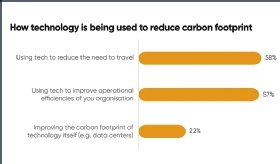
Max Topchii - stock.adobe.com
Businesses failing to cut carbon footprint of ‘power-hungry’ technology
Tackling the power consumption of datacentres features low on the list of tech leaders’ priorities, but pressures to change are growing
Companies are missing the opportunity to reduce the carbon footprint of power-hungry technology, according to a survey of digital leaders.
Chief executives and companies’ boards recognise that greener technology will improve their carbon footprint, but tackling the power consumption of datacentres and other energy-consuming IT systems features low on their list of priorities, according to Harvey Nash Group’s Digital leadership report.
Worldwide, datacentres consume an estimated 200TWh (terawatt-hours) of electricity each year, with digital technologies contributing up to 5.9% of global greenhouse emissions.
Emissions are at risk of rising further as companies plan to step up investments in technology, according to the Harvey Nash report, which predicts that sustainability will soon become a business imperative for technology leaders who will be asked to prioritise the reduction of energy consumption in future projects.
“Technology clearly has a really important role to play. Digital leaders can make a significant impact on their organisation’s carbon footprint,” said Bev White, CEO of Harvey Nash Group.
The report found that six in 10 digital leaders have used technology to reduce business travel and to make running their business more efficient.
However, reducing the carbon footprint of technology and IT systems presents a huge challenge for CIOs and digital leaders.

Harvey Nash’s survey shows that, so far, 22% of digital leaders say their organisations are making attempts to reduce the energy consumption of their datacentres and IT systems.
Many digital leaders and company boards have yet to consider the carbon footprint of their datacentres and whether they run on renewable energy or fossil fuels.
This contrasts with tech giants, such as Amazon, Apple, Google and Microsoft, which are either carbon neutral or have aggressive plans to become so.
Technology and datacentres have a greater impact on global warming than air travel, according to research quoted by Harvey Nash.
According to a study by the IEA, at the peak of worldwide lockdowns between February and April 2020 global internet traffic surged by 40%.
Demand for data and digital services is expected to grow exponentially, with global internet traffic expected to double by 2020.
Companies can also use data analytics to monitor their environmental impact across their supply chains and delivery chains to identify areas where they can cut electricity use.
Technologies, including the internet of things (IoT), machine learning (ML) and artificial intelligence (AI) can also provide companies with real-time feedback from their manufacturing systems, allowing them to cut energy consumption while at the same time extending the life of machinery.
Small steps, including unsubscribing from unwanted emails, using less energy-intensive search engines and using computers for longer before retiring them, can also add up across an organisation.
Read more on IT efficiency and sustainability
-
![]()
Enterprises advised to reconsider datacentre hosting locations on sustainability grounds
-
![]()
Google reveals how AI and machine learning are shaping its sustainability strategy
-
![]()
How India is moving towards net zero
-
![]()
IT sustainability strategies: Why enterprises need to start with the datacentre when going green









